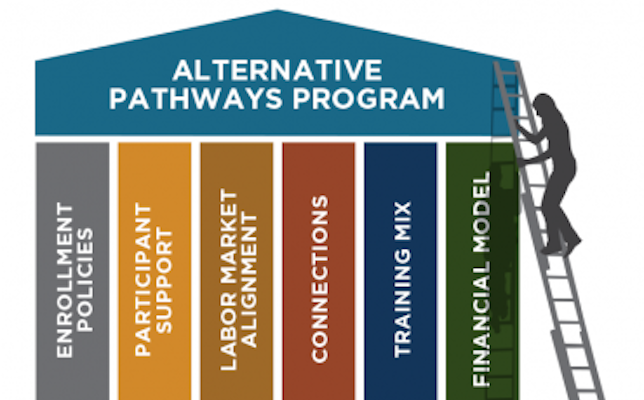Alternative Pathways Programs
Alternative Pathways Programs Could Fill Training Gap for Low-income Adults
- By Dian Schaffhauser
- 06/12/17
Could alternative pathways programs (APPs) provide an alternative to traditional education efforts in helping low-income adults change their economic prospects? That's the topic of two related reports from Tyton Partners, which examined the essential ingredients needed for success in APPs.
According to "Path to Employment: Establishing Effective Program Pillars," the idea behind APPs is to "explicitly prepare participants for validated, in-demand workforce opportunities." Such programs frequently offer "wrap-around services and support" that isn't always available with other educational opportunities. And, besides, stated author Adam Newman, those more standard training programs from community colleges, apprenticeships and workforce development efforts frequently show completion rates that are low for all kinds of reasons.

Image: Tyton Partners.
Low-income adults are those who are 18 or older, may or may not be employed, earn less than 200 percent of the federal poverty level (set in 2015 at $11,770 for a lone individual) and have limited or no exposure to college education. In the United States, the report noted, there are 25 million working, low-income adults.
As Newman pointed out, a college education is becoming a necessity. While just 28 percent of jobs in 1973 required an applicant to possess some form of postsecondary education that's expected to be 65 percent by 2020. Alternatives to college have gained steam. Certificate programs grew to make up 22 percent of postsecondary awards in 2012, and apprenticeships rose six percent annually between 2011 and 2015, Newman reported. But the available channels of education are insufficient to meet the need, the report asserted, and they have lousy completion rates. For example, in the state of California alone, there are about seven million low-income adults and possible post-secondary training programs (including community colleges, workforce development programs and apprenticeships) that can serve only about 2.2 million people. Of the 45 apprenticeship committees from various industries in California, only 12 report completion rates of higher than 70 percent.
Perhaps APPs provide another solution, the report offered. As Newman explained, an APP has three characteristics:
- It focuses on education and training for specific jobs and careers;
- It maintains tight alignment with employers and industries to help facilitate job placement for participants; and
- It doesn't offer a degree or certificate.
However, these programs too face challenges in scaling their reach if they're not well designed in six areas:
- Enrollment policies, the procedures and guidelines for accepting participants;
- Participant support, help in overcoming "life's challenges";
- Labor market alignment, to mesh with local employer needs;
- Connections to job opportunities;
- The training mix, to emphasis both soft skills and academic and technical skills; and
- The financial model, the ability to generate revenue for sustainability.
The report also examines how specific APPs are structured to address each area. For instance, 180 Skills and #YesWeCode both address hard and soft skills, while Flatiron School and Hack the Hood consider soft skills "ancillary" to core coverage of technical skills. Likewise, while Opportunity Junction guarantees participants jobs at the end of the program through its partners, StraighterLine makes "limited efforts" to support job seekers' search process. Each of those programs and others receive a more detailed examination in the second report, which is dedicated to profiling the APPs.
"While many of the leading APPs remain small and regionally focused, they offer models for innovative approaches to engaging adults and accelerating their workforce participation," Newman concluded. "'Path to Employment' represents an effort to call out the work of these dynamic organizations, highlight program design principles that underpin successful programs and engage stakeholders in a discussion as to how they can improve the efficacy and long-term outcomes for low-income adults through these programs."
The project was supported by the James Irvine Foundation. Both reports are available with registration on the Tyton Partners website.
About the Author
Dian Schaffhauser is a former senior contributing editor for 1105 Media's education publications THE Journal, Campus Technology and Spaces4Learning.

